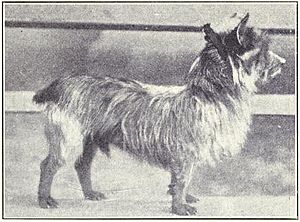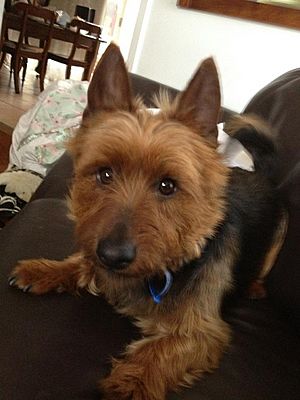Australian Terrier facts for kids
| Common nicknames | Aussie | ||||||||||||||||||||
|---|---|---|---|---|---|---|---|---|---|---|---|---|---|---|---|---|---|---|---|---|---|
| Origin | Australia | ||||||||||||||||||||
|
|||||||||||||||||||||
|
|||||||||||||||||||||
| Domestic dog (Canis lupus familiaris) | |||||||||||||||||||||
The Australian Terrier is a small dog breed that belongs to the terrier group. These dogs were first developed in Australia. However, their ancestors came from Great Britain.
Contents
All About the Australian Terrier's Look
The Australian Terrier is a small dog with short legs. They usually weigh about 6.5 kilograms (14 pounds). They stand about 25 centimeters (10 inches) tall at their shoulders, which is called the withers. They have a medium-length, shaggy, and rough double coat. This coat is usually not trimmed.
Their fur is shorter on their face, lower legs, and feet. They also have a fluffy ruff around their neck. Australian Terriers can have blue or silver fur with tan markings. They also have a lighter colored topknot on their head. Some can be solid red. In the past, their tails were often shortened, or docked. This was done to help protect them from injuries when they were working and hunting.
The History of Australian Terriers
The Australian Terrier comes from rough-coated terriers. These dogs were brought from Great Britain to Australia in the early 1800s. People kept these early terriers to catch mice and rats. The Australian Terrier shares ancestors with other terrier breeds. These include the Cairn Terrier, the Shorthaired Skye Terrier, and the Dandie Dinmont Terrier. Some Yorkshire Terriers and Irish Terriers were also part of their family tree.
The breed started to develop in Australia around 1820. At first, they were called the Rough Coated Terrier. The breed was officially recognized in 1850. Later, in 1892, they were renamed the Australian Terrier.
The first time an Australian Terrier was shown at a dog show was in 1906 in Melbourne. Around the same time, they were also shown in Great Britain. The The Kennel Club in the UK recognized the breed in 1933. The American Kennel Club recognized them in 1960. Today, many kennel clubs around the world recognize the Australian Terrier.
Australian Terrier Health
Australian Terriers are generally healthy dogs. They usually live for about 11 to 14 years. This is a typical lifespan for many purebred dogs.
Like all breeds, Australian Terriers can have some health issues. Some common problems include skin allergies. They can also have issues with their joints, like their kneecaps slipping out of place. Sometimes, they might get ear infections. It's always important for dog owners to take good care of their pets. Regular vet check-ups help keep them healthy.
Australian Terrier Temperament
Australian Terriers are known for being lively and alert dogs. They have a natural energy for hunting small animals. They are also very smart and can be trained well. This means they are good at learning commands and tricks.
These dogs usually get along well with other dogs. However, sometimes two male Australian Terriers living in the same house might not always agree. An Australian Terrier won't usually start a fight. But if they are attacked, they will stand their ground. They were also bred to be good companions. This means they love being around people and enjoy interacting with their families.
See also
 In Spanish: Terrier de Australia para niños
In Spanish: Terrier de Australia para niños




